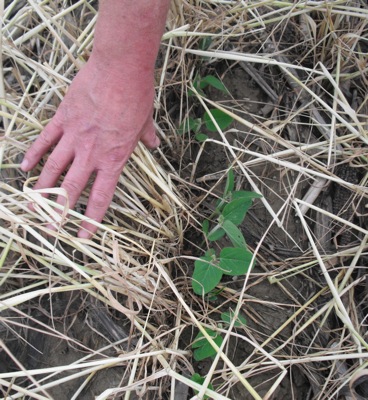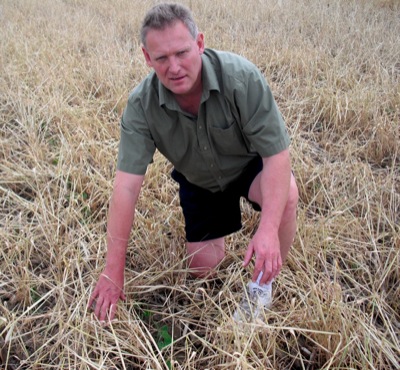Tuesday, May 25th, 2010
Farmers get grant to plant cover crops
By Nancy Allen

Photo by Nancy Allen/The Daily Standard
Celina area farmer Jeff Rasawehr shows how the residue from cereal rye grass, a winter cover crop, protected his soybeans from frost about two weeks ago. Rasawehr is among a group of farmers who received an $18,000 grant to plant cover crops.
Eight Mercer County farmers will split $18,000 in grant money during the next two years to plant winter cover crops as a way to help transition to no-till farming.
The grant comes from the USDA's North Central Region Sustainable Agriculture Research and Education Program (SARE).
This is the fourth cover crop grant local farmers have obtained this year with help from Mercer County OSU Extension Educator Jim Hoorman. He was hired about a year ago to help farmers with nutrient management issues.
Planting winter cover crops is one tool to help lessen nutrient and soil runoff. It also speeds up the transition from conventional tillage to no-till.
Celina area farmer Jeff Rasawehr is one of the farmers who received funds.
"It's expensive to plant cover crops, so the grants help," Rasawehr said. "But the residual positives we've been seeing in ensuing years makes it worth it."
Rasawehr has been planting red clover as a winter cover crop on his land for about 15 years. He also sells the hay and seed. Rasawehr said he will continue planting the cover crop because he noticed spring-planted corn and soybeans sewn in those clover fields produced higher yields over the years.
Last fall Rasawehr planted 220 acres of winter cover crops, cereal rye and winter pea. This spring those same fields were planted with soybeans and corn. His soybeans in fields with dead cereal rye residue were protected from frost that hurt some soybeans a few weeks ago.
"The area of field that didn't have cover crops, the beans got burnt by the frost and I'm not sure if they're going to survive yet," Rasawehr said.
Cover crops also can help hold fertilizer - both manure and commercial forms - in the soil, resulting in less leaching. This is better for the farmer and the environment, Rasawehr said.
Cover crops should be planted four to five years in a row to see consistency and benefits, which include alleviating soil compaction, increasing water infiltration, adding phosphorous and nitrogen to the soil for fall-planted crops, decreasing soil erosion and nutrient loss and adding organic matter to the soil.
In recent years, Hoorman has helped farmers plant more than 2,100 acres of cover crops in the Grand Lake Watershed, most of them with the help of federal dollars aimed at improving water quality.
Hoorman said the most recent grant also will pay to plant 4 acres of winter cover crops at the Mercer Wildlife Area.
Sean Finke, coordinator at the Mercer Wildlife Area, said he started planting winter cover crops at the wildlife area five years ago to improve water quality and soil health. He wants to transition to no tilling the land and is using cover crops to quicken that process. The winter cover crops also provide food for wildlife in the winter.
"The main one I like is Austrian pea because the duck and geese like it and deer too," he said.
Hoorman said the grant will pay for a test plot where Brother Nick Renner, local farmer and member of the Mercer County Soil and Water Conservation District, will use a machine he devised to detassle corn while simultaneously planting cover crops. Planting the cover crop earlier, while the corn is still in the field, will give the cover crop more time to grow, Hoorman said.
Rasawehr said he hopes he and the others who received the grant will have a positive experience with cover crops and be able to tell others.
"This is about improving the community and getting cover crops into the community," he said. "Hopefully we'll get others to try it."


